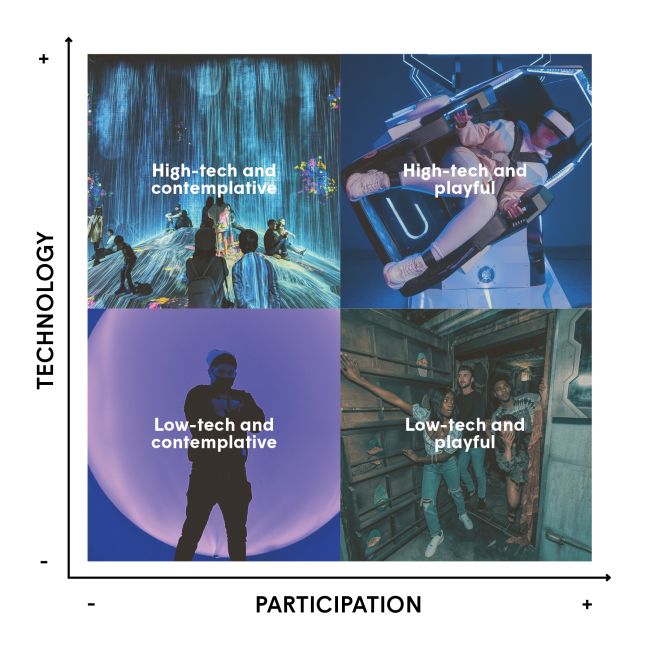Defining the spectrum of immersive location-based entertainment experiences

Photo credit: Convergence Station, Meow Wolf
Over the past decade, immersive experiences have boomed, taking many forms. This expansion has been a significant trend in the entertainment industry— according to Habo, in 2019, the immersive location-based entertainment (LBE) sector was worth nearly US$5 billion. Its growth continued in 2022 with a strong recovery from the slowdown imposed by the pandemic.
Due to the sector’s heterogeneous nature, understanding this large ecosystem remains a complex exercise. Despite the pre-eminence of a few market leaders, most of the immersive LBE industry is fragmented and largely composed of small players. They run, for example, escape games, immersive outdoor walkthroughs, immersive arcade games, interactive art centres or temporary “pop-up” experiences.
But what do we mean by immersive LBE?
Immersive experiences are a segment of location-based entertainment and take place in a dedicated location outside the home. They differ from conventional LBE in that they are highly engaging, allowing participants to immerse themselves in the content until they are fully absorbed by it. Ultimately, participants enter a flow state in which they lose track of time and self as their attention focuses entirely on the activity that is underway.
But what do we mean by immersive LBE?
Immersive experiences are a segment of location-based entertainment and take place in a dedicated location outside the home. They differ from conventional LBE in that they are highly engaging, allowing participants to immerse themselves in the content until they are fully absorbed by it. Ultimately, participants enter a flow state in which they lose track of time and self as their attention focuses entirely on the activity that is underway.
Immersiveness is the common thread running through these experiences, as their emphasis on technology and participation may vary. We can analyze immersive experiences using two axes that represent a spectrum of values:
Technology
This axis categorizes each experience according to how much technology it uses and how advanced the technology is.
Participation
This axis categorizes each experience according to participants’ level of involvement. Contemplative activities are based on observation and feelings, with no possibility of interacting with the experience. Play-oriented activities require active participation and include objectives that participants must pursue to make the most of the experience.
This categorization can be useful for analyzing market dynamics and gaining a better understanding of the competitive landscape. Products fall along a spectrum on each axis rather than forming a series of discrete categories. Experiences can range from exclusively contemplative to very playful, and all points in between. The emphasis on technology can also vary, ranging from purely analog experiences to strictly digital ones.
Immersiveness is the common thread running through these experiences, as their emphasis on technology and participation may vary. We can analyze immersive experiences using two axes that represent a spectrum of values:
Technology
This axis categorizes each experience according to how much technology it uses and how advanced the technology is.
Participation
This axis categorizes each experience according to participants’ level of involvement. Contemplative activities are based on observation and feelings, with no possibility of interacting with the experience. Play-oriented activities require active participation and include objectives that participants must pursue to make the most of the experience.
This categorization can be useful for analyzing market dynamics and gaining a better understanding of the competitive landscape. Products fall along a spectrum on each axis rather than forming a series of discrete categories. Experiences can range from exclusively contemplative to very playful, and all points in between. The emphasis on technology can also vary, ranging from purely analog experiences to strictly digital ones.
Parameters for immersive experiences categorized based on
their level of technology and participation
Parameters for immersive experiences categorized based on their level of technology and participation

Habo has divided the immersive experiences into eight categories characterized by varying levels of technology and participation.
Looking at current offerings that meet our criteria for immersiveness, we are struck by their diversity of type, format, theme and content.
The below visual positions each category of immersive LBE based on the level of technology and participation it involves.
Note that this is very much an off-the-rack picture and that each immersive experience concept has its own specific features.
Habo has divided the immersive experiences into eight categories characterized by varying levels of technology and participation.
Looking at current offerings that meet our criteria for immersiveness, we are struck by their diversity of type, format, theme and content.
The below visual positions each category of immersive LBE based on the level of technology and participation it involves.
Note that this is very much an off-the-rack picture and that each immersive experience concept has its own specific features.
Inventory of immersive products on the market by level
of participation and technology
Inventory of immersive products on the market by level of participation and technology

Immersive arcade games
Arcade games provide immersive experiences through the use of virtual reality, augmented reality or projection technology. Participants can play solo or in teams. They must move, press objects and interact with their virtual environment. These games deliver a multisensory experience (light, sound, graphics and animation) to participants as they vie for victory.
Immersive role-play and escape games
Life-size role-play and escape games completely immerse participants in a realistic world. Participants team up or compete with others to solve problems, share ideas and hunt for clues in beautifully recreated settings as they work to reach their final goal. To play the game, participants may be assigned a character to carry out their mission.
Immersive Family Entertainment Centres (FECs)
Family Entertainment Centres (FECs) use vivid, detailed settings, realistic characters, and interactive elements to get the whole family playing and having fun as they run, slide, shoot targets and explore new worlds. Exciting visuals, activities and sounds create a sense of wonder.
Immersive theatre, movies, and evenings
Participants attend an immersive event, complete with characters played by actors, realistic story-driven sets, and sound and light effects that create a sense of entering a new world. Participants establish an immediate connection with the story or theme and can influence the way it unfolds.
Immersive excursions
These attractions use virtual reality, augmented reality and projection technologies to create a unique universe. A narrative thread guides participants on a trip to another country, another time period or an entirely new world. It’s an adventure of discovery that broadens their horizons. Participants may have the opportunity to contribute directly to the story.
Immersive outdoor walkthroughs
Outdoor light trails can be experienced solo or in groups. These trails are punctuated with spectacular stops that wow participants with multimedia projections, light shows and music to create a full-on immersive experience.
Immersive exhibitions
These exhibitions use multimedia to plunge visitors into incredible immersive environments. Exhibition-goers can wander from world to world, each with its own realistic setting, spectacular projections, captivating sound effects, and music that plays to the emotions. Or they can simply stay in one place and contemplate their surroundings.
Pop-up immersive experiences
Picture-taking is encouraged at these vivid, flamboyant immersive experiences. Participants explore settings that showcase pop art, retro colours, dazzling lights and strange landscapes. Visitors can touch and admire amusing, off-the-wall elements of decor and share pictures and videos on social media.
Immersive arcade games
Arcade games provide immersive experiences through the use of virtual reality, augmented reality or projection technology. Participants can play solo or in teams. They must move, press objects and interact with their virtual environment. These games deliver a multisensory experience (light, sound, graphics and animation) to participants as they vie for victory.
Immersive role-play and escape games
Life-size role-play and escape games completely immerse participants in a realistic world. Participants team up or compete with others to solve problems, share ideas and hunt for clues in beautifully recreated settings as they work to reach their final goal. To play the game, participants may be assigned a character to carry out their mission.
Immersive Family Entertainment Centres (FECs)
Family Entertainment Centres (FECs) use vivid, detailed settings, realistic characters, and interactive elements to get the whole family playing and having fun as they run, slide, shoot targets and explore new worlds. Exciting visuals, activities and sounds create a sense of wonder.
Immersive theatre, movies, and evenings
Participants attend an immersive event, complete with characters played by actors, realistic story-driven sets, and sound and light effects that create a sense of entering a new world. Participants establish an immediate connection with the story or theme and can influence the way it unfolds.
Immersive excursions
These attractions use virtual reality, augmented reality and projection technologies to create a unique universe. A narrative thread guides participants on a trip to another country, another time period or an entirely new world. It’s an adventure of discovery that broadens their horizons. Participants may have the opportunity to contribute directly to the story.
Immersive outdoor walkthroughs
Outdoor light trails can be experienced solo or in groups. These trails are punctuated with spectacular stops that wow participants with multimedia projections, light shows and music to create a full-on immersive experience.
Immersive exhibitions
These exhibitions use multimedia to plunge visitors into incredible immersive environments. Exhibition-goers can wander from world to world, each with its own realistic setting, spectacular projections, captivating sound effects, and music that plays to the emotions. Or they can simply stay in one place and contemplate their surroundings.
Pop-up immersive experiences
Picture-taking is encouraged at these vivid, flamboyant immersive experiences. Participants explore settings that showcase pop art, retro colours, dazzling lights and strange landscapes. Visitors can touch and admire amusing, off-the-wall elements of decor and share pictures and videos on social media.
Understand what consumers value
Consumers are looking for immersive experiences that make them laugh, learn or marvel. To succeed, owners and operators of immersive experiences must first gain a deep understanding of their audience and market. Ambitious leaders must look beyond their own niche and draw inspiration from successful immersive experiences across categories on the spectrum.
Understand what consumers value
Consumers are looking for immersive experiences that make them laugh, learn or marvel. To succeed, owners and operators of immersive experiences must first gain a deep understanding of their audience and market. Ambitious leaders must look beyond their own niche and draw inspiration from successful immersive experiences across categories on the spectrum.



